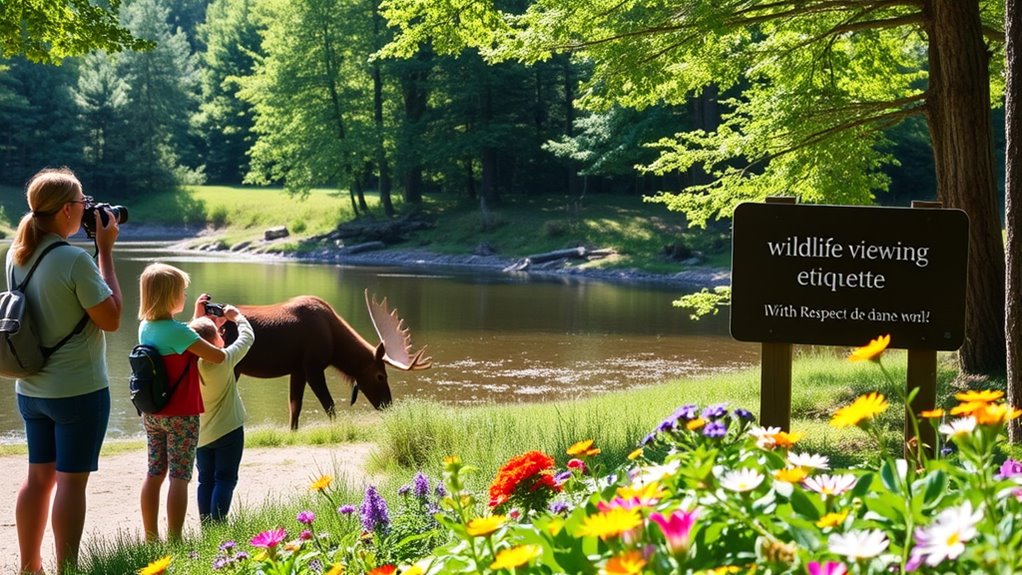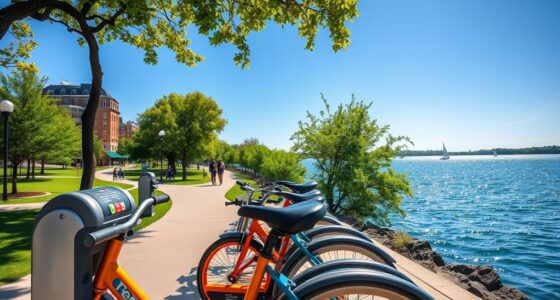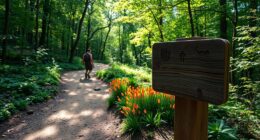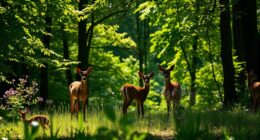When observing wildlife in Acadia National Park, keep a respectful distance to minimize stress on the animals. Use binoculars or zoom lenses for a better view, and maintain quiet to avoid startling them. Avoid feeding or luring wildlife, as it disrupts their natural behaviors. Always follow park regulations to protect both the animals and their habitat. By respecting these guidelines, you’ll enhance your experience and the animals’ well-being. Discover more about responsible wildlife interactions.
Key Takeaways
- Maintain a respectful distance from wildlife to avoid stress and protect natural behaviors.
- Observe quietly, keeping noise to a minimum to avoid startling animals.
- Avoid feeding and luring wildlife to prevent dependency and health issues.
- Use binoculars or zoom lenses to enhance viewing without disturbing animals.
- Follow park regulations and guidelines to promote wildlife preservation and safety.
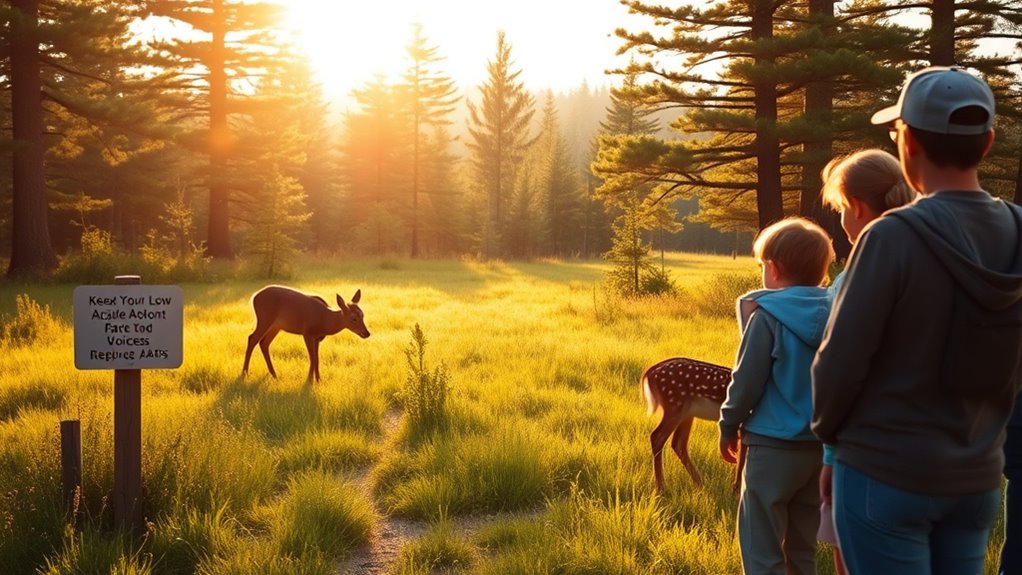
When you venture into nature to observe wildlife, it’s essential to remember that you’re stepping into their home. This means you need to tread lightly and show respect for the creatures that inhabit the landscapes around you. In Acadia National Park, where diverse wildlife thrives, practicing good wildlife viewing etiquette is vital for both your safety and the well-being of the animals.
One of the most important rules to keep in mind is to maintain a respectful distance. Animals in the wild can be unpredictable, and approaching them too closely can lead to stress or defensive behavior. Whether you’re hoping to catch a glimpse of a moose, a deer, or a busy bird, using binoculars or a camera with a zoom lens allows you to observe from afar. This way, you’ll not only protect yourself but also give the wildlife the space they need to go about their lives without feeling threatened.
Alongside maintaining a respectful distance, quiet observation is key to a successful wildlife viewing experience. Animals are highly attuned to their environment, and loud noises can startle them, causing them to flee or hide. You’ll want to minimize your impact by keeping conversations to a whisper and turning down any music or sounds from your devices. By being quiet, you not only enhance your own experience but also increase the chances of seeing animals behaving naturally, which is often the most rewarding aspect of wildlife watching.
Remember, your aim is to observe, not to interfere. If you see an animal, resist the urge to feed or lure it closer for a better photo. Doing so can disrupt their natural behaviors and can even be harmful. Instead, focus on enjoying the moment from a distance. Take mental snapshots, appreciate their beauty, and let them exist in their natural habitat.
Lastly, be sure to respect the park regulations regarding wildlife viewing. These rules are in place to protect both you and the animals. Familiarize yourself with guidelines specific to Acadia National Park, and follow signage that indicates safe viewing practices. By adhering to these principles, you’ll not only enjoy a more fulfilling wildlife experience but also contribute to the preservation of these incredible ecosystems for future visitors. Additionally, understanding the importance of wildlife preservation can enhance your appreciation for these interactions.
In essence, by keeping a respectful distance and practicing quiet observation, you’ll create a positive experience for yourself and the wildlife you seek to admire.
Frequently Asked Questions
What Time of Year Is Best for Wildlife Viewing in Acadia?
The best time for wildlife viewing in Acadia is during spring and early summer. You’ll witness seasonal migrations as birds return, making it perfect for spotting various species. Late spring also marks bird nesting, so keep an eye out for active nests and fledglings. Fall offers a different experience, with animals preparing for winter. Each season provides unique opportunities, so plan your visits accordingly to maximize your wildlife encounters.
Are There Specific Areas in the Park Known for Wildlife Sightings?
Did you know that Acadia is home to over 300 species of birds? When you’re exploring the park, head to wildlife hotspots like Jordan Pond and Cadillac Mountain for the best chances of sightings. Don’t miss the viewing platforms that offer stunning vistas and prime opportunities to spot deer, foxes, and various bird species. Make the most of your visit by keeping your eyes peeled for the park’s incredible wildlife!
Can I Bring My Pet While Wildlife Viewing in the Park?
You can’t bring your pet while wildlife viewing in the park. Pet regulations require that pets stay on designated trails and are leashed at all times. This helps protect both your pet and the wildlife. Unleashed pets can lead to harmful animal encounters, disturbing the natural behaviors of wildlife. To enjoy the park, consider leaving your pet at home or finding pet-friendly areas outside of the wildlife viewing zones.
What Should I Do if I Encounter an Aggressive Animal?
Encountering an aggressive animal can feel like stepping into a storm; you need to seek shelter fast. Stay calm, back away slowly, and don’t turn your back on the animal. Make yourself appear larger by raising your arms or backpack, and avoid direct eye contact, which can provoke it further. Always remember essential safety precautions, like carrying bear spray in certain areas, and educate yourself on local animal behavior to minimize risks.
Are There Guided Wildlife Tours Available in Acadia National Park?
Yes, there are guided wildlife tours available in Acadia National Park. You can join ranger-led safaris that provide a fantastic opportunity to observe local wildlife while learning about their habitats. These tours are designed to enhance your experience, allowing you to spot animals you might miss on your own. Be sure to check the park’s schedule for availability and times, so you can make the most of your wildlife viewing adventure!
Conclusion
So, when you’re out in Acadia, remember: you’re not just a visitor; you’re a wildlife whisperer! Keep your distance, respect their space, and don’t feed the critters—unless you want a squirrel to start demanding five-star meals! By following these etiquette tips, you’ll not only help conserve the park but also ensure your wildlife encounters are magical and memorable. After all, nothing beats the thrill of spotting a moose without it asking for your lunch!

